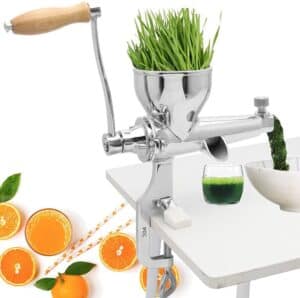
As a result, they add new features to their juicers and gain an extra share, spreading controversial information and myths to aid with their marketing campaigns. This controversial information intends to make people think that a specific juicer model must be the ultimate go-to kitchen appliance.
Read More: Tribest Z‑Star Z‑710 Manual Juicer Review — Best Entry Masticating Gadget
There are the following myths promoted by some juicers manufacturers and distributors about the juice parameter extracted by the different juicers styles:
- The higher speed at which centrifugal juicers run cause more heat buildup than the slow juicers, therefore destroying vital enzymes the fresh juice should contain;
- Centrifugal juicer’s higher RPM increases oxidation and foaming action, hence decreasing the nutritional value of juice produced;
- All nutrients and enzymes are preserved if masticating juicers are used to juice since they do not generate heat during juicing;
- The masticating singles auger juicers are constructed with a dual or triple-stage auger that allows them to extract a juice with 80% more enzymes, 90% more nutrients, and 50% less pulp than other standard juicer models.
What is right, what is wrong from the statements above, and what affects the juice quality? Here are the facts about juice quality from the above statements.
Table of Contents
Centrifugal Juicers Heat the Juice

For instance, an apple juice processed using a slow juicer increases temperature by only 8–11 degrees Fahrenheit compared to the unprocessed apple’s temperature. At the same time, a centrifugal juicer will increase the juice temperature extracted from the apple by 11–14 degrees Fahrenheit. This is because any friction action automatically increases the temperature of the juice. Take an example of the same apple; if you process the apple using a manual crank single auger juicer, the temperature increases by 10 degrees Fahrenheit.
From this test, we can conclude that any juicer type during the juice extraction changes the initial temperature of the food product. If an electric juicer is used, the temperature of extracted juice increases several degrees higher than using a manual crank juicer. You note that the more the friction, the higher the temperature increase. Yet, all manual crank masticating, centrifugal, twin gear, and single auger juicers will yield nutritious, fresh, and live juice with a lot of enzymatic content. There is nothing wrong with an increase in juice temperature, provided it does not increase beyond 48 C/118 F degrees. As long as you start with cold food ingredients, your juice will be nutritious. Nutritional damage (if any) from juice heating during the extraction will be very minimal.
Centrifugal Juicers Oxidize the Juice

Notably, all juicers cause oxidation in food ingredients. During the juicing process, some juicers produce more oxidation than others. Centrifugal juicers are known to cause more oxidation than slow juicers, though the extent of oxidation is not as much as most advertisers claim. Even the damage that it produces is not very significant; the marketing tricks make it exaggeratedly important.
The truth is when using a slow masticating juicer; you are guaranteed to break down fiber materials found in vegetables and fruits thoroughly. A complete breakdown of these materials will produce a more nutritious juice. The slow masticating juicers work well due to their ability to grind and chewing action, which disintegrates food ingredients better than centrifugal action. Therefore, more nutritious juice from a slow-masticating juicer is not contributed by its slow-motion effect. Imagine you are to select either a 60 RPM or 46 RPM vertical single-auger slow masticating juicer model or a 43 RPM model. Between the two slow juicer models, which one do you think produces more nutritious juice? None, simply because the production of nutritious juice is not all about speed but about the grinding process. When selecting between a 46 RPM vertical single-auger slow masticating juicer and 110 RPM twin auger slow masticating juicers, the higher-speed twin auger juicer will extract more nutritious juice because it grinds ingredients more thorough than the single auger vertical slow juicer.
It is worth noting that, oxidation of juice also increases the longer extracted juice sits around. Therefore, it is advisable to consume your juice immediately after juicing it. By doing this, you will minimize the chances of oxidation. Worry no more about oxidation from your centrifugal juicer.
A Slower Juicer Extracts Superior Juice and More Juice

Just like in juice quality, the difference in juice yield is not so straightforward. It is commonly known that most masticating juicers are more versatile, although you will spend a lot more of your time during juicing. When choosing the best slow juicer among many models, their speed will not be a significant factor influencing their juice quality or yield.
Deceptive Claims By Chinese Juicers Distributors

Other manufacturers boast and claim that their single auger masticating juicer models have triple or dual-stage auger pressing action. The single auger juicers have more or less standard auger shape, which most Chinese manufacturers copy from South Korean reputable brand juicers, and there is no stage in a single auger that exists. They also will persuade consumers to believe that their superior juicing screen will remarkably increase juice yield. Generally, the Chinese manufacturers do not invent new screens; they only dupe the existing, usually old, models of South Korean juicers. In contrast, more critical stages among different juicer brands cause an insignificant increase in juice yield.
As juicer manufacturer tries their best to rise to the pinnacle against their competitor, juicer customers get a cumbersome experience. This troublesome experience is witnessed as consumers try their luck and get an “upgraded” Chinese model with “superb features”. Continuous “division” of the standard auger into more juicing stages is just another trick to kick out one’s competitors and usually has no genuine advantage.
Final Thoughts
Finally, you no longer need to worry much about juice oxidation. Juice oxidation is an aspect that most manufacturers have deployed to influence your purchase option. However, the buildup of heat in a juicer is not a genuine factor in determining the extent of oxidation since any juicer style can increase the temperature of food ingredients.
The centrifugal juicer model can produce beneficial and high-quality juice. This is all you need to know. However, if you prioritize extracting the highest juice quality, then you can opt to purchase a slow-masticating juicer. For instance, if one has a severe medical condition that demands high-quality juice in the diet, then one cannot take chances on such a health issue and buy a twin auger masticating slow juicer.
You have to understand that centrifugal juicers are good-quality juicers that work efficiently to produce nutritious juice full of enzymes. Although these juicer models are known to increase oxidation, it is now undebatable that consuming fresh juice is much healthier than taking pasteurized or shelf-stable juice with fewer enzymes. Therefore centrifugal juicers are a useful style of juicers that can turn out to be of great use, especially in busy households, since they are easy and quick to use.



